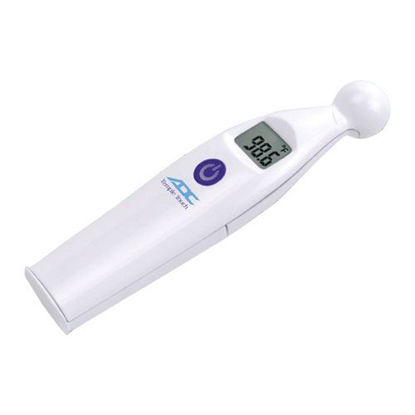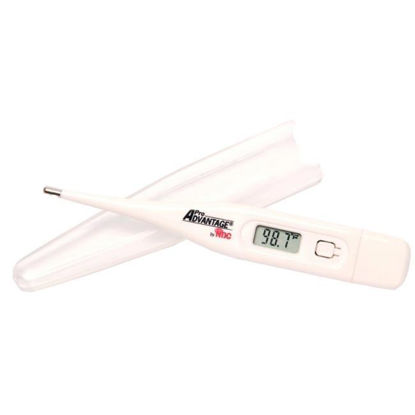- Brands
- Blog
- About Us
- Contact
- Daily Living Aids
- Catheters
- Compression Stockings & Socks
- Medical Cushions for Seating & Bedding
- Medical Incontinence Supplies
- Infection Control Supplies
- Ostomy Supplies
- Personal Care Medical Supplies
- Respiratory Care
- Wheelchairs & Accessories
- Wound Care Supplies
Thermometers: Your Guide to Temperature Measurement.
A thermometer is an essential medical device used to measure body temperature accurately. In this guide, we'll explore the different types of thermometers, including the best ones for fevers, how to ensure accuracy, and the functionality of probe and forehead thermometers. Both oral and forehead thermometers provide a digital reading. A medical thermometer is a staple item to include in a first aid kit. Additionally, we'll provide instructions on how to take an oral temperature for accurate readings.
What is a Thermometer?
A thermometer is a device designed to measure temperature accurately. It consists of a sensor or probe that detects temperature changes and displays the reading on a digital or analog scale. Thermometers are widely used in medical settings, homes, and various industries to monitor body temperature, environmental conditions, and process temperatures.
Best Type of Thermometer for Fevers
The best type of thermometer for measuring fevers depends on personal preference and the age of the individual. Common types include digital oral thermometers, ear thermometers, temporal artery thermometers, and infrared forehead thermometers. Digital oral thermometers are widely recommended for their accuracy and ease of use, especially for adults and older children.
Ensuring Thermometer Accuracy
To ensure the accuracy of your medical thermometer, follow these tips:
- Calibration: Regularly calibrate your thermometer according to the manufacturer's instructions to maintain accuracy.
- Proper Placement: Place the thermometer probe in the correct location for the most accurate reading, such as under the tongue, in the armpit, or in the ear canal.
- Cleanliness: Keep your thermometer clean and free from debris to prevent contamination and ensure accurate readings.
- Comparison: Compare the readings of your thermometer with a known accurate thermometer to verify its reliability.
Probe Thermometer
A probe thermometer, also known as a digital stick thermometer, features a slender probe that is inserted into the mouth, rectum, or armpit to measure body temperature. These thermometers provide accurate readings and are suitable for all age groups, including infants and young children.
Forehead Thermometer
A forehead thermometer, also known as a temporal artery thermometer, measures temperature by scanning the temporal artery on the forehead. It is non-invasive, quick, and convenient, making it ideal for use with infants, young children, and individuals who prefer not to use oral or rectal thermometers.
Taking an Oral Temperature
To take an oral temperature using a digital thermometer:
- Prepare the Thermometer
- Place the Probe
- Wait for Reading
- Record the Temperature
- Clean and Store
In conclusion, thermometers play a crucial role in monitoring body temperature accurately. By understanding the different types of thermometers, ensuring accuracy, and following proper usage guidelines, you can effectively monitor temperature changes and take appropriate actions when necessary for optimal health and well-being.
ADC ADTEMP - Temple Touch Thermometer
- Non-invasive digital thermometer
- Accurate readings in about six seconds
- Uses 2 AAA batteries, included
ADC ADTEMP - Thermometer Probe Covers
- Fits all digital instant read thermometers
- Prevents cross contamination
- Cost effective
ProAdvantage - Digital Thermometer
- Measures body temperature in 60 seconds
- LCD readout, audible beep upon completion
- Probe covers eliminate cross contamination risk
- Includes: thermometer, five probe covers, battery, case, and instructions
Thermometers: Your Guide to Temperature Measurement.
A thermometer is an essential medical device used to measure body temperature accurately. In this guide, we'll explore the different types of thermometers, including the best ones for fevers, how to ensure accuracy, and the functionality of probe and forehead thermometers. Both oral and forehead thermometers provide a digital reading. A medical thermometer is a staple item to include in a first aid kit. Additionally, we'll provide instructions on how to take an oral temperature for accurate readings.
What is a Thermometer?
A thermometer is a device designed to measure temperature accurately. It consists of a sensor or probe that detects temperature changes and displays the reading on a digital or analog scale. Thermometers are widely used in medical settings, homes, and various industries to monitor body temperature, environmental conditions, and process temperatures.
Best Type of Thermometer for Fevers
The best type of thermometer for measuring fevers depends on personal preference and the age of the individual. Common types include digital oral thermometers, ear thermometers, temporal artery thermometers, and infrared forehead thermometers. Digital oral thermometers are widely recommended for their accuracy and ease of use, especially for adults and older children.
Ensuring Thermometer Accuracy
To ensure the accuracy of your medical thermometer, follow these tips:
- Calibration: Regularly calibrate your thermometer according to the manufacturer's instructions to maintain accuracy.
- Proper Placement: Place the thermometer probe in the correct location for the most accurate reading, such as under the tongue, in the armpit, or in the ear canal.
- Cleanliness: Keep your thermometer clean and free from debris to prevent contamination and ensure accurate readings.
- Comparison: Compare the readings of your thermometer with a known accurate thermometer to verify its reliability.
Probe Thermometer
A probe thermometer, also known as a digital stick thermometer, features a slender probe that is inserted into the mouth, rectum, or armpit to measure body temperature. These thermometers provide accurate readings and are suitable for all age groups, including infants and young children.
Forehead Thermometer
A forehead thermometer, also known as a temporal artery thermometer, measures temperature by scanning the temporal artery on the forehead. It is non-invasive, quick, and convenient, making it ideal for use with infants, young children, and individuals who prefer not to use oral or rectal thermometers.
Taking an Oral Temperature
To take an oral temperature using a digital thermometer:
- Prepare the Thermometer
- Place the Probe
- Wait for Reading
- Record the Temperature
- Clean and Store
In conclusion, thermometers play a crucial role in monitoring body temperature accurately. By understanding the different types of thermometers, ensuring accuracy, and following proper usage guidelines, you can effectively monitor temperature changes and take appropriate actions when necessary for optimal health and well-being.






